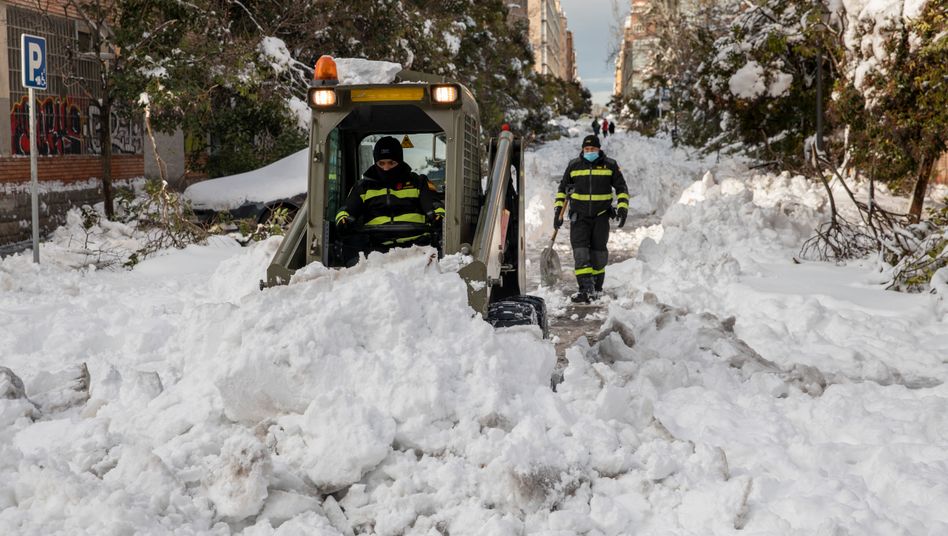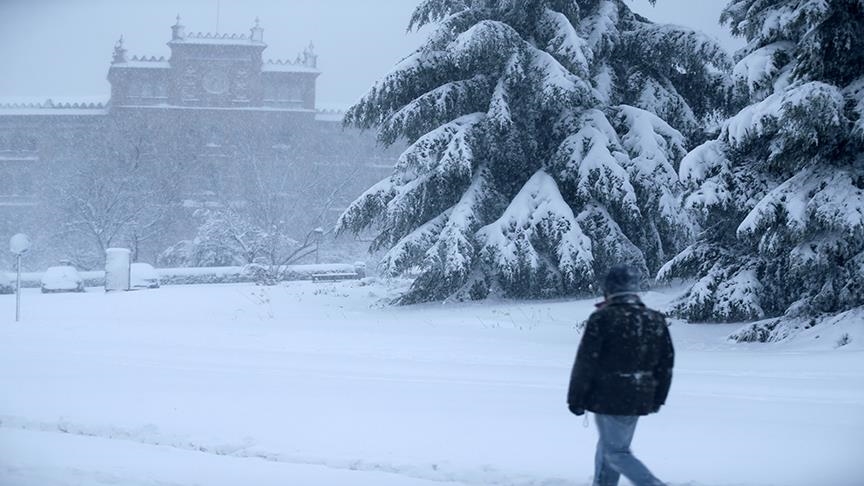Does it snow in Spain in the winter? (2023)
Affiliate links
This post might contain affiliate links. If you make a purchase through this link I will earn a small commission at no extra cost to you. As an Amazon Associate I earn from qualifying purchases. But I will only recommend products and services I believe are of value for you. Thank you so much for your support.
We all know Spain as one of the sunniest and warmest countries in Europe. But what is it actually like in the cold season – does it snow in Spain in winter? Surprisingly, snowfall can also occur on the Iberian Peninsula and its islands. In this article, you will find exactly where, when, how often, and how much snow Spain gets.
Having lived in Spain for several years, I have already experienced several winters in Spain. Here, you can learn more about snowfall in Spain. So let’s get started right away and clarify the most critical question:
What to find out in this post
- 1 Does it snow in Spain in the winter?
- 2 Climate Zones in Spain
- 3 Where does it snow in Spain?
- 4 How often does it snow in Spain?
- 5 Does it snow in Barcelona?
- 6 Does it snow in Madrid?
- 7 Does it snow in Mallorca?
- 8 Does it snow in Valencia?
- 9 Does it snow in Seville?
- 10 Does it snow in Granada?
- 11 Does it snow in the Canary Islands?
- 12 Does Spain get snow? – More FAQ about Snow in Spain
Does it snow in Spain in the winter?
Indeed, it snows in many regions of Spain in the winter. Theoretically, snowfall can occur throughout the entire country. Especially in higher areas, such as the Pyrenees, the Sierra Nevada, and in the country’s interior, you can usually expect snowfall.
Climate Zones in Spain
With its unique location and nature, Spain’s climate is not easy to summarize. This is because Spain is divided into five different climate zones.
While the eastern part of the Iberian Peninsula has a relatively mild Mediterranean climate (mild winters and warm to hot summers), the country’s interior is dominated by a continental climate, which implies more significant differences between summer and winter.
The western part of the country has an oceanic climate, with a lot of precipitation, cooler summers, and mild winters.
The country’s mountains, on the other hand, are dominated by a harsh mountain climate with cold winters and cool summers.
A particular condition arises in the Canary Islands, which are located much further south than the Iberian Peninsula.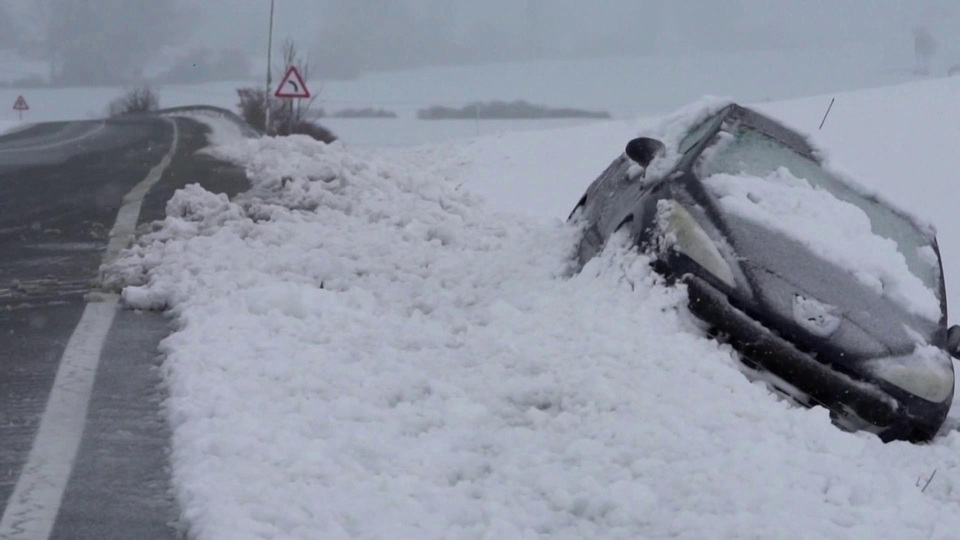
Where does it snow in Spain?
While theoretically, snowfall can occur anywhere in Spain, it snows particularly heavily in the mountainous and Atlantic regions, as well as inland. There is significantly much snow in the Pyrenees and the Sierra Nevada mountain range, as well as in the Spanish region of Castilla y León.
Below, you will find a small overview of the most popular and snowiest places in Spain.
Ávila
View of Ávila covered with snow
Ávila is one of the unique places in Spain and is not only popular with national visitors and day trippers for its magnificent city walls. The massive fortifications are considered a UNESCO World Heritage Site and have been standing here since the 11th century.
However, many people don’t know that in winter, the city of Castile-León can turn into a true winter wonderland. With an average of 20 snow days a year between December and February, Ávila is covered in a layer of snow on some days.
Particularly popular for snowy excursions in the region around Ávila is the Sierra de Gredos mountain range, with an altitude of up to 2,591 meters (8,500 ft.).
Burgos
The snow-covered Burgos
The small city of Burgos in Castile and Leon is a popular day trip from Madrid all year round. But especially in winter, when a thin layer of snow covers Burgos, a visit to the Spanish city is worthwhile.
Burgos is especially popular for its important Gothic cathedral, recognized as a UNESCO World Heritage Site.
Snowfall in Burgos is typically between late December and early March, with January considered the snowiest month, when the city is covered by a snowpack averaging 29 mm (1.14 in).
Cuenca
View of the hanging houses of Cuenca
Cuenca in Castilla-La Mancha is definitely a unique place. Namely, the small town is located on a hill.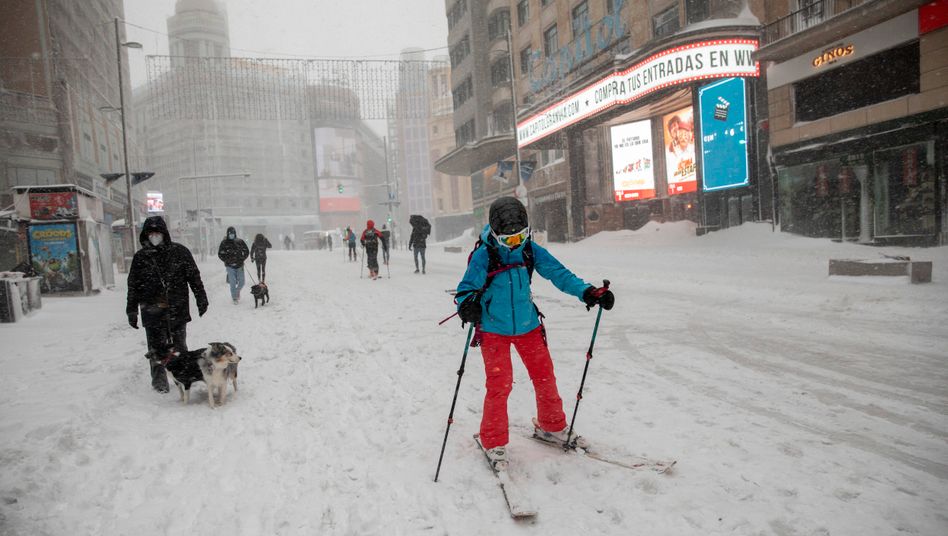
Even today, three of these so-called hanging houses can be visited and entered.
With an altitude of almost 950 meters (3,116 ft), snowfall is quite common here during the cold winter. Especially popular are trips in the snowy area, such as the highest mountain in the region, the Cerro de la Mogorrita.
Huesca
Snowy Huesca at night
Huesca is the second largest city in the region of Aragon. Located in the southern foothills of the Pyrenees at an altitude of almost 500 meters (1,640 ft.), it can get quite cold here in the winter months.
Surrounded by beautiful nature, Huesca is a popular vacation destination for national and international visitors all year round. However, it is especially worth visiting in winter, when a thin layer of snow covers the city.
In the province of Huesca, there are all kinds of snow-covered winter areas at higher altitudes.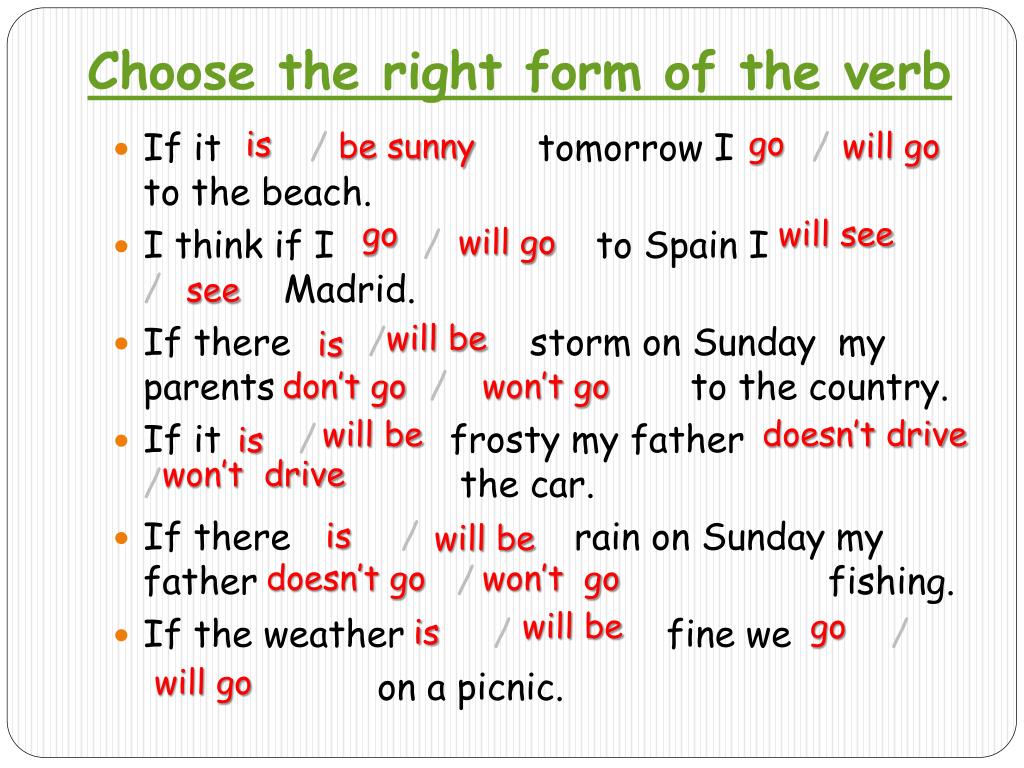
León
View of the impressive cathedral of León
León, in the Spanish community of Castile-León, is historically one of the most important cities in the country. Founded as early as the 01st century AD, the city was once the capital of the Kingdom of León, which later developed into the Spanish state.
With its altitude of 837 meters (2,746 ft) above sea level, snowfall is frequent in winter. An average of 13.6 snow days means that a total of 98 mm (3.85 in) of snow accumulates here, making the city one of the snowiest in the country.
La Molina
The ski resort La Molina in Catalonia
Also, here in Catalonia, there are various options for a snowy getaway. One of the most popular places for snow in my adopted homeland is the ski region of La Molina.
Just a few kilometers from the French border, the ski resort is located at an average altitude of around 1,700 meters (5,577 ft) above sea level.
Pamplona
View of the cathedral of Pamplona in Navarre
Pamplona in the Spanish region of Navarre is another excellent snow destination in Spain. As a pilgrimage city on the Way of St. James, the Spanish town is well-visited at any time of year. But especially during the San Fermin Festival in summer.
What many people don’t know, however, is that a visit to Pamplona is also worthwhile in winter, when the city is regularly covered in a layer of snow.
On average, it snows in Pamplona for 9.7 days a year.
The Pyrenees
View of a snowy landscape in the small Pyrenees state Andorra
If you think of Spain and snow, you can hardly miss the Pyrenees. This mountain range separates the Iberian Peninsula from the rest of Europe. Because of its mild summers and cold winters, it is considered one of the most popular vacation regions in the country.
The Pyrenees are primarily located in Spain but also partly belong to France and the small state of Andorra. With more than 200 peaks over 3,000 meters (9,843 ft) high, it is hardly surprising that snow lies here for much of the year (up to six months a year). The massive mountain range extends to the Atlantic coast in the west and borders the Mediterranean Sea in the east.
Salamanca
Salamanca is a city in Castilla y León that has not yet been heavily taken over by tourism. It is known for its great Spanish cuisine, pure Castilian Spanish, and cultural and educational institutions.
The so-called golden city of Spain is located at an altitude of about 800 meters (2,624 ft) above sea level, making it another snowy city on the Iberian Peninsula.
Particularly popular as a day trip from Salamanca is the Sierra de Béjar-La Covatilla ski resort, which offers its visitors 26.8 km (16.65 mi) of ski slopes.
Segovia
the famous aqueduct of Segovia
Let’s move on to another important city in Castilla y León (maybe you already recognize the pattern of where it snows most in Spain?!).
Maybe you have heard about the impressive aqueduct of Segovia, which rises from the cityscape.
At an altitude of 1,002 meters (3,287 ft) above sea level, you can expect an average of 13 days of snow a year.
Sierra Nevada
View of the snowy hills of Sierra Nevada
The Andalusian mountain range, Sierra Nevada, is not only the highest point of the Iberian Peninsula but also one of the snowiest places in the country. With the highest point of 3,482 meters (11,423 ft) at Mount Mulhacén and a total of 16 peaks with an altitude of more than 3,000 meters (9842 mi), snowfall can occur here for up to nine months a year.
With almost 85 km (52.8 mi) of slopes, Sierra Nevada is considered a popular destination by the Spanish city of Granada and one of the most important ski resorts in Europe.
Already the name, which can be translated in English as “snowy mountain range,” indicates the abundance of snow in the mountains.
Soria
Soria is a small town in Castile and Leon, still unknown to international visitors. Among the locals, however, the small town is a real insider tip for a great snow trip in winter.
With just about 21.4 snowy days a year, the small town is considered one of the five snowiest cities in Spain. At an altitude of 1,065 meters (3,494 ft), the high snow occurrence in Soria is not at all surprising.
Particularly popular, with or without snow, is the historic old town of Soria with its beautiful Plaza Mayor.
Teruel
In the historic center of Teruel
Teruel is considered one of the most beautiful small Spanish towns and is, therefore, a popular place to visit all year round – as a principal destination or even as a day trip from Valencia. One of the attractions of the small town is its well-preserved Mudejar architecture, which has even earned Teruel the designation of UNESCO World Heritage Site.
The small town is located at an impressive altitude of 915 meters (3,001 ft) and is prone to winter snow.
Val d’Aran, Lleida
The snowy Baqueria-Baret in the Catalan Aran Valley
The last Spanish snow destination on our list is the Aran Valley, also called Valle de Arán in Spanish (the official name Val d’Aran is its Catalan name).
Located in the far north of Catalonia, on the border with France, the valley has a special status. With various peaks over 2,000 meters (6,562 ft) high (the highest peak is at 3,014 meters [9,888 ft]), it’s hardly surprising that you can expect plenty of snow here during the winter.
In addition to countless hiking trails and vast nature, the Baqueria-Baret ski area, the second largest ski area in the Pyrenees (after Grandvalira in Andorra), is especially popular with visitors.
How often does it snow in Spain?
In general, it can be assumed that snow falls in Spain every year in winter. Especially in the higher regions of the country, such as the mountains of the Pyrenees and the Sierra Nevada, it snows regularly during the winter months.
Does it snow in Barcelona?
Unusual picture: Barcelona beach covered with snow, 2012
In Barcelona, it snows pretty rarely. However, snowfall can occur in winter. Usually, it snows, if it does, only very lightly, and the snowflakes rarely remain. However, in recent years, there has been (light) snow from time to time.
On average, however, it snows in Barcelona only 0.4 days per year, accumulating an average of 3 mm (0.12 in) of snow.
However, during my almost seven years in Barcelona, I have only experienced one good day of (very) light snow.
Does it snow in Madrid?
The snow-covered Gran Vía during the Filomena snowstorm in January 2021.
Madrid may well experience snowfall in winter, although it is not a very snowy city. On average, it snows about 3.6 days a year in the Spanish capital.
In January 2021, Madrid was in the news worldwide for a snowfall of the century that covered the Spanish capital with a snow depth of up to 60 cm (23.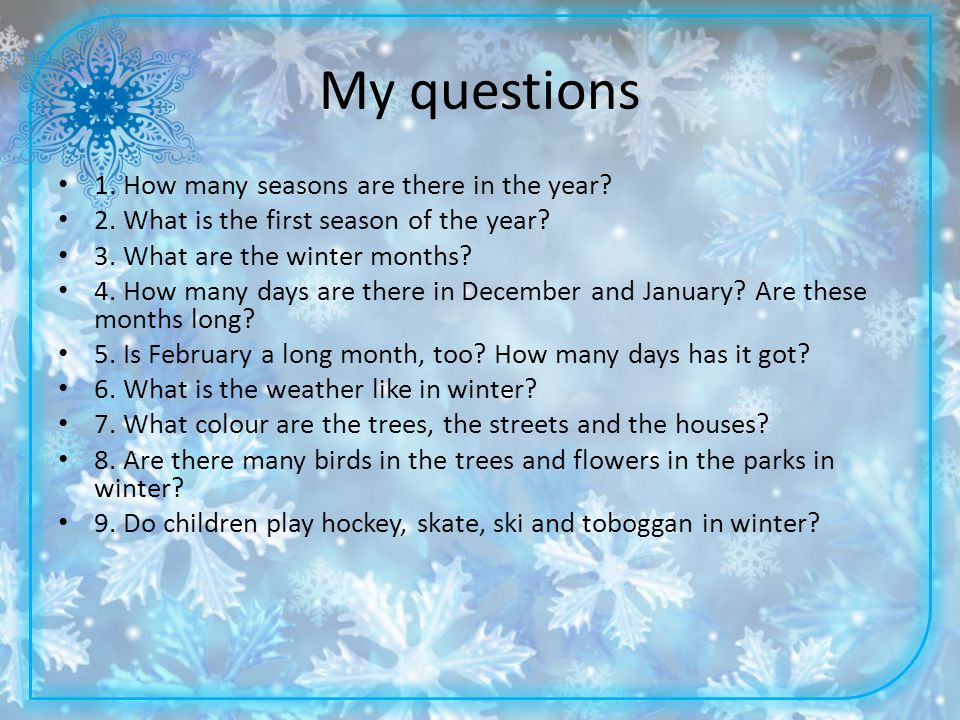
Does it snow in Mallorca?
Few people know this side of Mallorca: The snow-covered Sierra de Tramuntana
Surprisingly, it snows in Mallorca every year. However, the snowfall is usually limited to the Sierra de Tramuntana, the mountain range in the island’s north. Outside the mountains, snowfall is relatively rare and limited to an average of 0.4 days per year.
Does it snow in Valencia?
The historic center of Valencia covered in snow is probably rather unlikely.
It does not usually snow in the Spanish city of Valencia. If snow does fall on very rare occasions, it is generally in the higher regions of the Valencian Community.
Particularly popular to see snow in the Valencia region are the small towns of Chelva, Camporrobles, and El Rincón de Ademuz.
Does it snow in Seville?
The famous Plaza de España in Seville is rarely covered with snow
Snowfall in Seville is very, very rare. But when it does snow, such as in 2010, the snow usually does not remain but melts again immediately.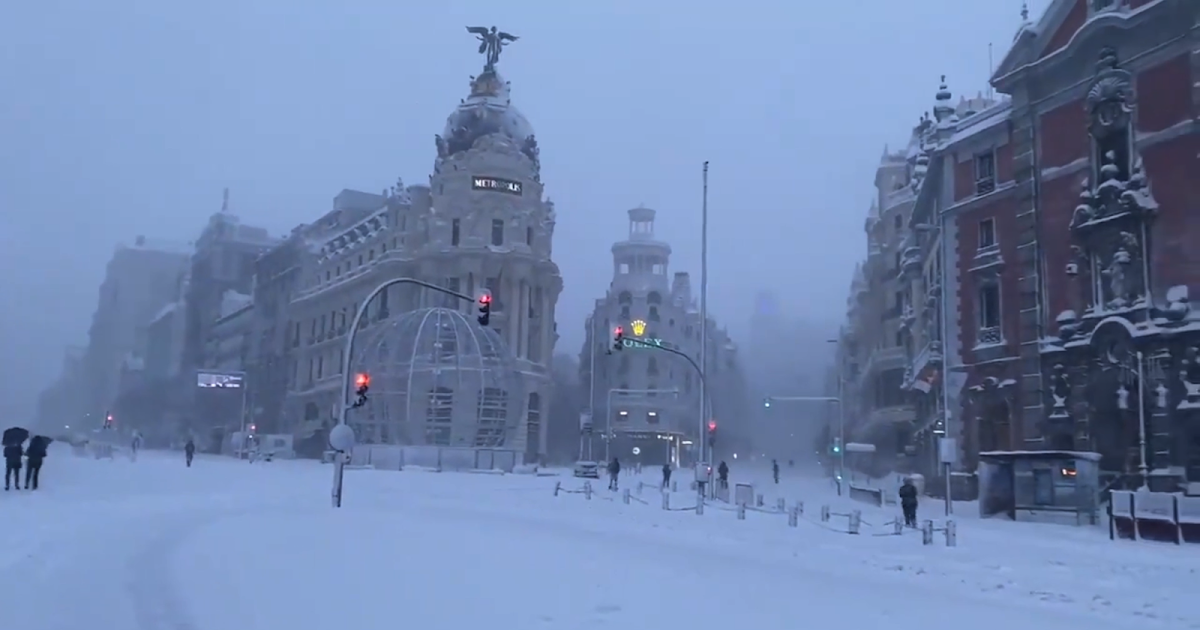
Does it snow in Granada?
View of the famous Alhambra
Although Granada is located relatively far south of Spain, snowfall in Granada is not that unrealistic. On average, it snows 0.5 days a year in Granada. In fact, every few years, the Andalusian city is covered by a thin layer of snow.
The most likely snowfall is across the famous Alhambra, which towers slightly above the city.
On the other hand, the nearby Sierra Nevada gets snow every year.
Does it snow in the Canary Islands?
The snowy peak of El Teide in Tenerife
Surprisingly, snowfall can occur in the Canary Islands. However, this only happens in the higher mountain regions above 1,600 meters (5,250 ft). The rest of the country has a subtropical climate, so snowfall is impossible.
In the Teide National Park in Tenerife, snow occurs annually in the higher mountain regions.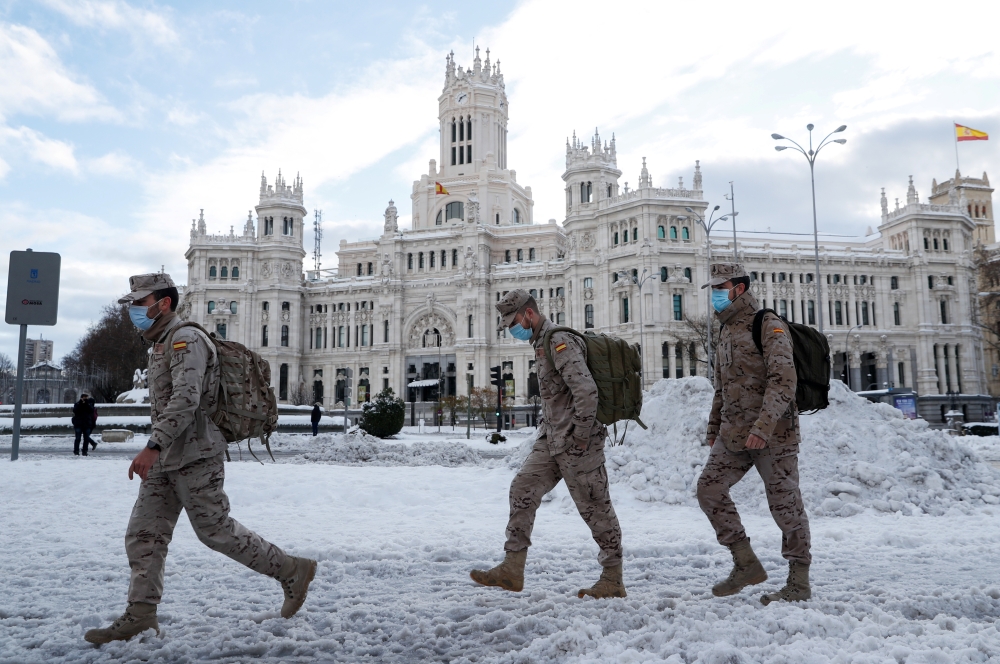
Does Spain get snow? – More FAQ about Snow in Spain
Why is it so cold in Spain?
With its location on the Iberian Peninsula, Spain is primarily surrounded by water. Especially in the coastal region, strong winds and high humidity are common. Due to this, the perceived temperature is usually below the actual temperature.
How to say Snow in Spanish?
Snow in Spanish is translated as Nieve. It is believed that the Spanish word Nieve is derived from the Latin word nivis.
Has it ever snowed in Spain?
Surprisingly, it snows regularly in Spain during the winter months. While snow is relatively rare in many places on the Iberian Peninsula, snowfall occurs yearly in higher regions.
Where is it warm in Spain in the winter?
Compared to other European countries, it is warm almost everywhere in Spain during the winter.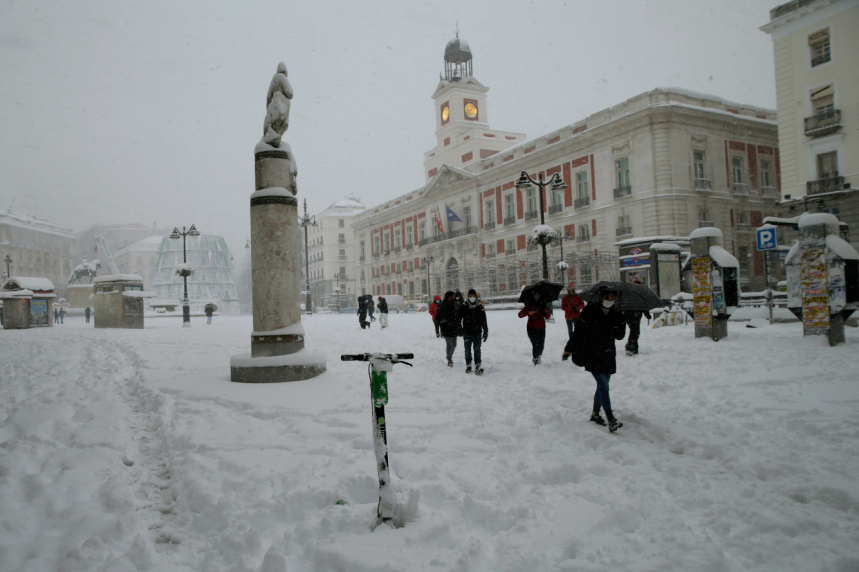
What is the coldest temperature in Spain?
The coldest temperature ever measured in Spain is -35.8 °C (-32,44° F). It was recorded in Vega de Liordes near León in Castile-León in 2021.
When does it snow in Spain?
In the snowy regions and elevations of Spain, it snows primarily during the winter between December and early March, with January as the snowiest month.
What is the snowiest place in Spain?
It is believed that the Spanish Pyrenees and the Sierra Nevada mountain range are the snowiest places in Spain. On the other hand, the Spanish city of Ávila is considered the snowiest city in Spain.
See all our Spain Posts
About the AuthorVicki
Hi, we are Vicki & Eduardo, an international travel couple on a mission to help you save money for priceless travel experience.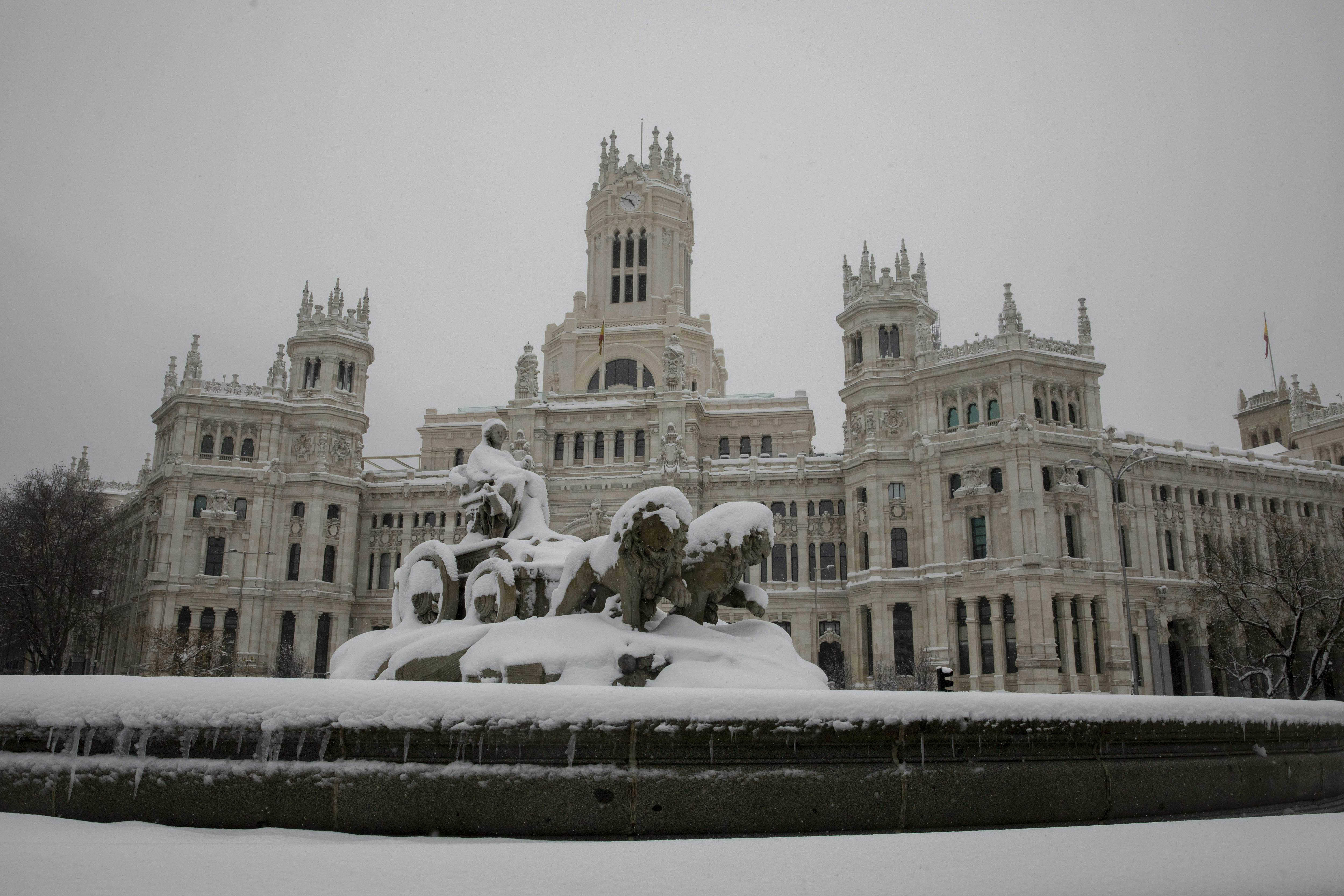
More about us
18
shares
-
Share
-
Tweet
Does it Snow in Spain? (This will Surprise You!)
0
shares
Yes, it does snow in Spain! It might be hard to imagine that Spain experiences snow at all as it is often associated with the image of never-ending Mediterranean sunny days – but some regions receive quite a bit of snowfall during the winter months. Spain might not be the winter destination one thinks of when it comes to winter sports; however – owing to its diverse topography – Spain touts a few regions where it is possible for you to enjoy winter activities, especially if you fancy being hugged by the delightful chill of the snow!
Table of Contents
The Nature of Snowfall in Spain
Spain is an elevated plateau, and some parts of the country can get quite chilly during winter.
Urban cities like Barcelona doesn’t receive much snowfall due to the urban heat effect, which is a common phenomenon that can be witnessed in industrialised cities – the urban heat effect lends to the fact that human activities keep temperatures low. Cities like Barcelona gets a few hours of snow, but all traces of snow disappear the following day. The only instance Barcelona experienced a heavy snowfall was in 2018; it was caused by a climatic change called the Beast from the East, which affected most European cities.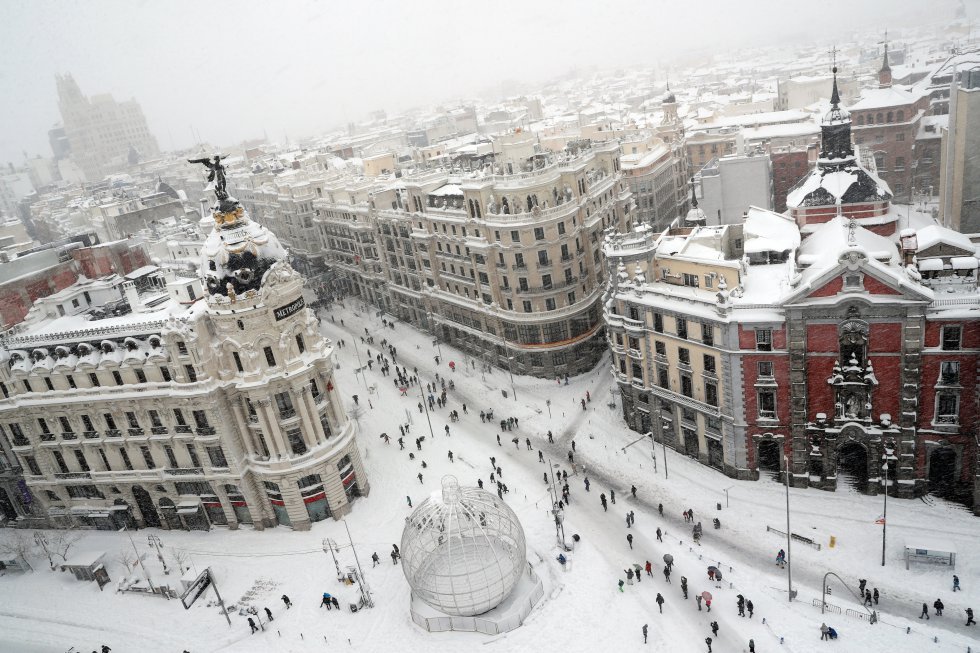
Climate in Spain
Spain is among the top ten countries with the most diverse climatic conditions; the climatic diversity of the country is what makes it appealing to travellers. The only European country that shares a border with Africa – the country is bounded by Morocco – Spain is situated in the Iberian Peninsula, claiming 85% of the peninsula. The country has 13 climatic zones in total; five out of which bear the most influence on Spain’s climate. Hot-summer Mediterranean climate, warm-summer Mediterranean climate, oceanic climate, warm-summer continental climate, and semiarid climate are the five major climatic zones that characterise Spain’s climate. The minor sub-zones include humid subtropical climate, hot desert climate, dry continental climate, and alpine and subarctic climate.
When/How often does it Snow?
In Spain, snow falls from December to April, with April experiencing the highest density of snow. December is the first winter month, and places like Madrid and Lugo get extremely cold with temperatures below 3 ℃.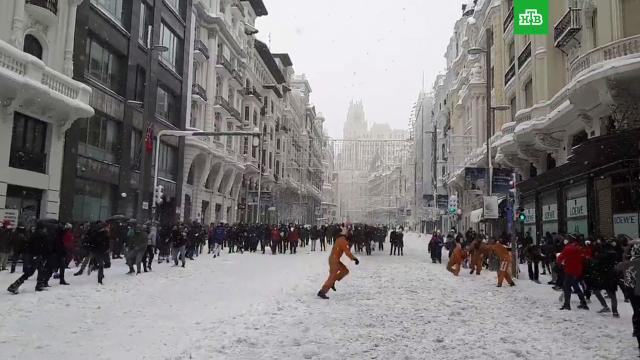
The northern region gets freezing cold in February, with an average temperature of 7℃, but temperatures start to go up again during February. Northern Madrid is the coldest region in January with continental winters. Also, the Pyrenees Mountain range freezes up during winter months, with temperatures falling below zero degrees and consistent snow falling.
Where Can you See Snow in Spain?
Sierra de Gredos, Ávila
If you are visiting Spain during winter, you are in for a frosty holiday! Several places come alive with winter festivities, snow-clad mountain tops, ski resorts, and hiking routes covered in snow.
Sierra de Gredos, Ávila
Location
One of the most enchanting landscapes in Spain, Sierra de Gredos should be included in your winter itinerary. While Sierra de Gredos is a year-round travel destination, during the winter months, it becomes particularly alluring, with snow-draped hiking routes and mountain terrains.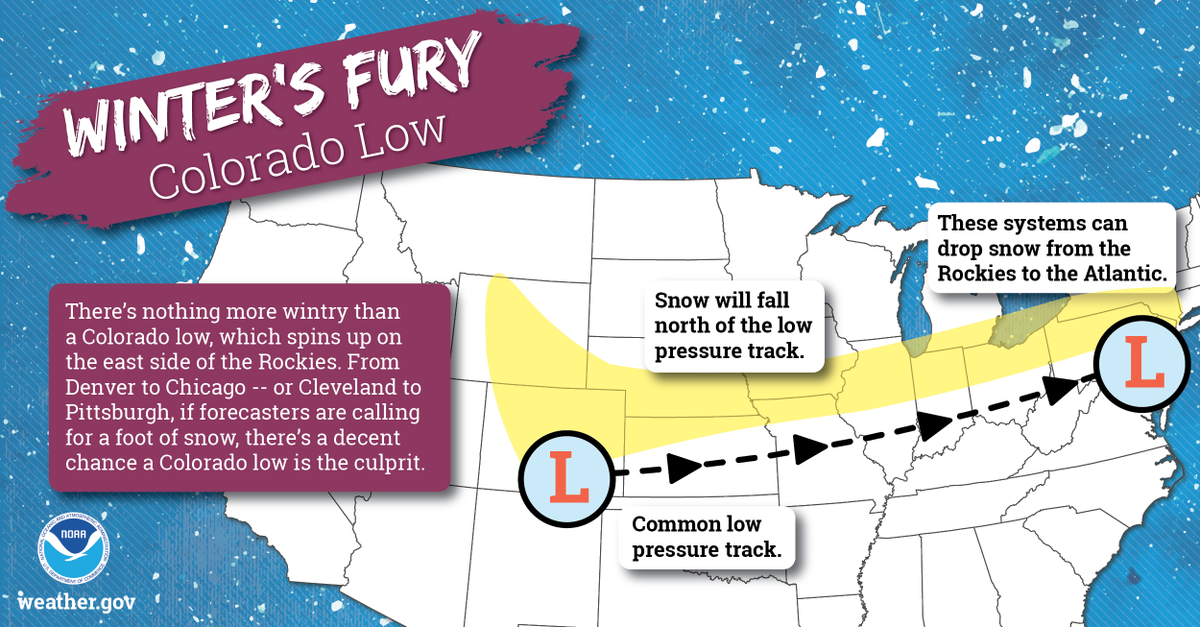
Valle de Arán, Lleida
Location
With a range of possibilities, Valle de Arán is an invitation for travellers with an appetite for winter sports. Skiing and hiking are the two main activities to be enjoyed here and added to the list of attractions is gothic and Romanesque architecture. You can also drop in at one of the restaurants and sample the best bits of Aranese cuisine. Natural hot springs, which are a Roman creation and a popular tourist attraction in Valle de Arán, are worth visiting, too.
Comarca De Sobrarbe, Huesca
Location
Known for Pineta and Ordesa valleys, Sobrarbe is another Spanish region where you can see snow. Nature photographers are drawn to the area for landmarks like Monte Perdido. Hiking is a popular activity around here, but when there’s enough snow, some tour companies offer walks through the snow-drenched forests. If you find yourself in Sobrarbe during winter, make sure you have time for a visit to Aínsa, a Spanish medieval village that assumes its most beautiful countenance when there’s snow.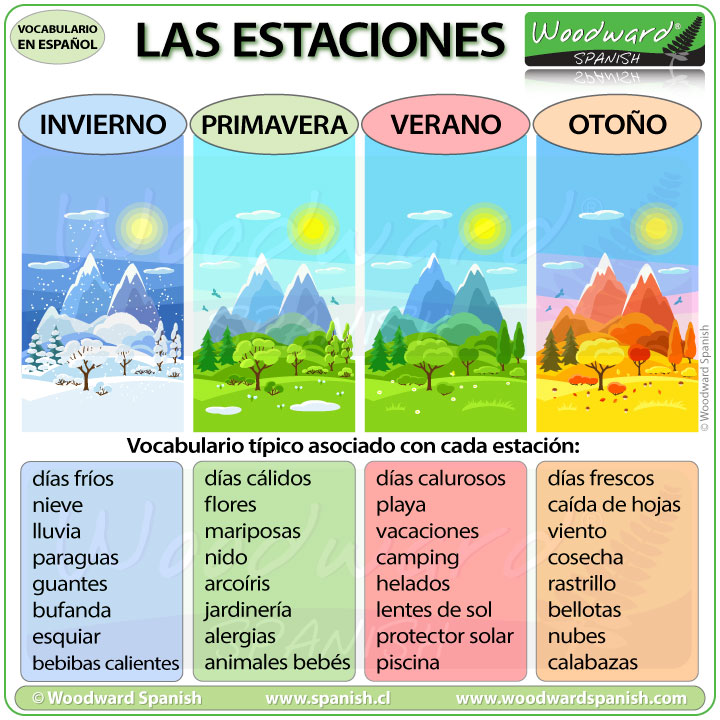
Sierra de las Nieves, Malaga
Location
Found in the southern region of Spain, Sierra de las Nieves is a natural park that becomes a strikingly beautiful image during winter months – the name translates to ‘snowy mountain range’. This UNESCO recognised biosphere offers a memorable experience during summer, but it outdoes itself during winter.
Rascafría, Madrid
Location
A coveted family destination, Rascafría is an easy journey from Madrid. The trail to the Cascada del Purgatorio waterfall is the key attraction here. The route doesn’t get too crowded with tourists, and it is one of the few places in Spain where you can experience the quintessence of a European winter.
Best Places to Visit in Spain during Winter, and Things to do!
Snowfall in Salamanca, Spain
To mingle with the young crowds and witness historic buildings lavish with winter festivities, visit Salamanca. Logrono, on the other hand, has an excellent culinary scene coupled with historic architecture; visitors to Logrono are also treated to some of the best wines.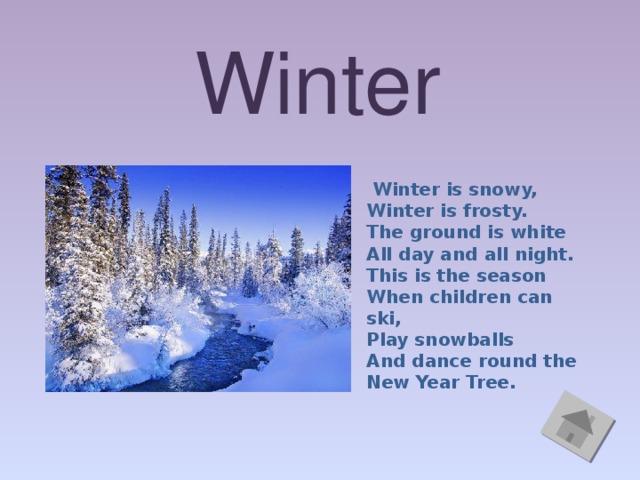
To see some greenery in the winter months, you should head to San Mateo, Cantabria. And there’s no better place than Malaga to cast your eye upon gorgeous architecture and step back in time while enjoying the season’s magic. Sightseeing, hiking, skiing, dining, and visiting ancient buildings are some of the things you can do in Spain during winter, and if you haven’t shaken off that summer feeling yet, visit the Canary Islands for some absolutely gorgeous white sandy beaches.
You might also like: Places to Visit in Spain
Spain offers a plethora of unique experiences for those who visit during winter; they might not necessarily be the typical winter things to do, but they are remarkably unique and make for a fun winter getaway!
where to find snow in Spain — idealista
Where to find snow in Spain?
Aleix Rafegas Farré on Unsplash
November 25, 2021, Edit
When we think of Spain, we usually think of sun-drenched beaches and seaside vacations, but in fact, Spain is a country of extremely diverse geographical landscapes.
From Spanish ski resorts to isolated mountain peaks perfect for hiking or a child’s first contact with snow… we bring you an overview of the best of winter Spain: best trails and snow landscapes .
- Sierra de Gredos, Ávila
- Valle de Aran, Lleida Madrid
- Sobrarbe Region, Huesca
- Sierra de las Nieves, Malaga
- 900 029
Sierra de – Gredos, Avila
Sierra de Gredos
Flickr
The Sierra de Gredos is without a doubt one of the most beautiful places in Spain . Many tourists who come here in winter go to Navarredonda de Gredos and Hoyos del Espino, from where the easiest hiking trails lead.
If you already have mountain hiking experience, then we recommend visiting Laguna Grande de Gredos . From the “Platform Gredosa” (car park at Hoyos del Espino) you can walk to Laguna in about 2 hours.
Here you will discover stunning ice landscapes.
If you have an advanced level of hiking, your goal should definitely be to reach Almanzor, located 2591 meters above sea level.
- Vacation rental in Sierra de Gredos
- Houses for sale in Arenas de San Pedro
Valle de Aran, Lleida
Valle de Arán
Flickr
it’s snowing: skiing on skiing in Baqueira, as well as “via ferrata” , hiking and a varied artistic heritage of Romanesque and Gothic architecture in other areas. The best way to fully enjoy this Catalan valley is to combine activities with a visit to the thermal spa and dinner to experience the best of Aranese cuisine.
The tradition of natural hot springs in this area of Catalonia dates back to the Romans and there are many spas nearby, such as Termas de la Baronia in Le , that are worth trying.
More than 180 restaurants are at your disposal for the gastronomic route, distributed throughout the region, with gourmet cuisine with “olla aranesa” – a dish that stands out from the rest with its hearty, stewed mixture of sausages, beans and vegetables.
- Holiday rentals in Valle de Arán
- Houses for sale in Valle de Arán
Sobrarbe Region, Huesca 9002 Com3 del 9003
Flickr
Pineta , popular for its photogenic peaks such as Monte Perdido and adored by nature and rural tourism lovers.
The area is usually associated with hiking, and when there is enough snow, several companies offer put on your snowshoes and walk along the snow-covered forest trails .
Finally, make sure you don’t miss Aínsa, one of the most beautiful medieval villages in Spain, while in the area, which is even more spectacular covered in snow, and be sure to take photos to please your Instagram followers.
- Holiday rentals in Comarca del Sobrarbe
- Houses for sale in Sobrarbe
Sierra de las Nieves, Malaga
Snow in Malaga
Flickr
It seems like a joke that the Sierra de las Nieves Natural Park is somewhere to the north with snow-capped mountains 9014 Spain like Huesca and Lleida, and in the southern province of Malaga. The area has been declared a Biosphere Reserve by UNESCO and if it’s beautiful in the summer, seeing it covered in snow is a truly unforgettable experience.
The best way to get to the park is through the cities of Juncker or Tolox and we recommend that you take this trip to also enjoy the beauty and grandeur of Ronda.
- Holiday rental in Sierra de las Nieves
- Houses for sale in Ronda
Rascafria, Madrid 9003 9003
Rascaía Flickr
If you want to wallow in the Spanish snow with your children, we recommend the city of Rascafriya in the region of Madrid and especially the route to the waterfall Cascada del Pulgatorio .
The trail is not too difficult, very visible and not too crowded in winter. To start your hike, once you get to Rascafrià, look for the car park “Las Presillas” and start from there.
You will definitely fall in love with Rascafria, which for many is a corner of Switzerland in the center of the province of Madrid . You will not be indifferent to its history, architecture and wonderful food.
- Vacation rental at Rascafría
- Houses for sale in Rascafría
Tags
Mountains of Spain
What to see in Spain
Vacation spots WINTER. | HISPANISTA
HISPANISTA SPANISH COURSES IN SPB ABOUT SPAIN AND ITS LIFE.
8 PLACES IN SPAIN WHERE THE RUSSIAN WINTER HAPPENS.
Contrary to stereotypes, snow and cold weather are not so unusual for hot Spain. Some places know how to build snowmen very well and keep scarves, hats and gloves in the home wardrobe.
So, let’s take a trip to the coldest places in Spain, where the thermometer can show a temperature of minus 30 and snow outside the window.
- Torre de Cabdella, Lérida
Here the lowest temperature of minus 32 degrees was recorded in the winter of 1956. This Catalan municipality consists of 19 villages, among which stands out Estavill – a town that has been best preserved since the Middle Ages.
- Calamocha, Teruel
This area is as famous for its cold winters as it is for the excellent ham they produce. The temperature record in the history of the city is only slightly inferior to Lleida. December 17 1963 years old, the thermometer dropped to minus 30 degrees. But the beauty of these places is worth visiting even in winter. Moreover, the inhabitants are always ready for the cold and can lend you gloves and a hat. Having warmed up, you can safely go to see the beauties of the old quarter and the medieval bridge over the Jiloca River.
- Molina de Aragón, Guadalajara
Molina de Aragón also distinguished itself in the 60s of the last century with its -28.2º, taking the third place in the ranking. But if you are a history lover, then you should go here in any case to see one of the largest fortresses and important monuments in Spain, Castillo-Alcázar. Along the way, you can linger in the Moorish and Jewish quarters
- Albacete
In 1971, at Los Llanos airport, the thermometer showed “amazing” minus 24 for Spain. Here is the Plaza de Toros, which became the model for the creation of the plaza de Las Ventas in Madrid – the largest bullring in the country.
5. Burgos
Burgos is without a doubt one of the coldest, but also the most charming cities in Spain. You can come here just to admire the streets, squares and small corners of the medieval town.

 Here you will discover stunning ice landscapes.
Here you will discover stunning ice landscapes. 

 The trail is not too difficult, very visible and not too crowded in winter. To start your hike, once you get to Rascafrià, look for the car park “Las Presillas” and start from there.
The trail is not too difficult, very visible and not too crowded in winter. To start your hike, once you get to Rascafrià, look for the car park “Las Presillas” and start from there.  So, let’s take a trip to the coldest places in Spain, where the thermometer can show a temperature of minus 30 and snow outside the window.
So, let’s take a trip to the coldest places in Spain, where the thermometer can show a temperature of minus 30 and snow outside the window. 